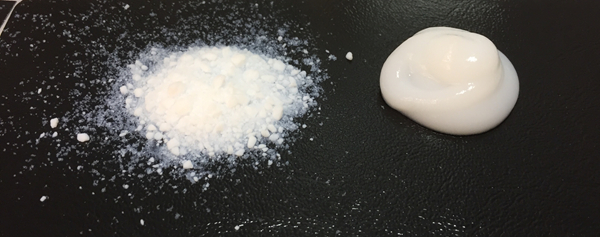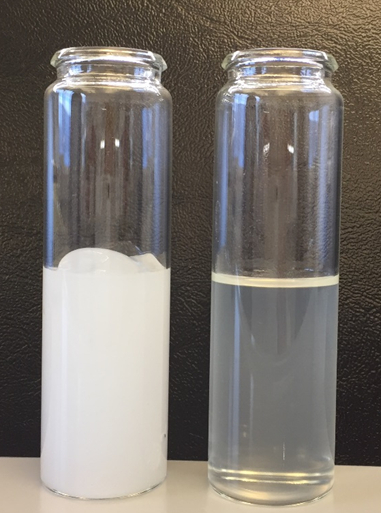
Microfibrillated Cellulose vs. Fumed silica: characteristics and applications
Synnøve Holtan | December 13, 2016
Microfibrillated cellulose (MFC) and fumed silica are both used for controlling the rheology of liquid systems, such as thixotropy and stability, and may be used within the same field of applications giving similar properties. However, there are also profound differences between the two. For example, where MFC is a natural product derived from cellulose-based raw materials, the native hydrophilic fumed silica is an amorphous, colloidal silicon dioxide prepared by a flame hydrolysis process. So why can two such, at first glance, different products be used in similar applications? In this blog post, I will dig more into detail about the two multifunctional additives, and discuss how their similarities and differences may affect application properties.

Figure 1. Hydrophilic fumed silica (DC 98%, left) and MFC (DC 2% in water, right).
How are the material characteristics of the two products?
Fumed silica is regarded a unique material due to its unusual particle characteristics. Its primary structure consists of branched aggregates formed by the fusion of nonporous spherical SiO2 particles by hydrolysis at over 1000°C. On cooling, the aggregates mechanically entangle to form agglomerates (tertiary structures). Because of the small diameters of the primary particles and the open structure of the agglomerates, fumed silica has a very high surface area. It is a light, fluffy powder that is white in appearance and is used in many applications and a variety of industries (Figure 1, left).
MFC usually comes as a water suspension and is made by fibrillating cellulose fibers longitudinally, giving an advanced three-dimensional network of cellulose microfibrils with a high surface area (Figure 1, right). With cellulose microfibrils that have diameters even down to the nanometer range and lengths in the micrometer range, MFC contributes to material strength and gives a new dimension of stability to various formulations. How can the particle nature of fumed silica and the long, thin microfibrils of MFC function similarly in applications?
.jpg?width=1336&name=Microscopy%20(1).jpg)
Figure 2. Optical microscopy of 0.65% MFC (left, Exilva by Borregaard) and fumed silica (right) in PEG 400. 20x magnification (phase contrast).
The large surface area-to-mass ratio for both fumed silica and MFC causes intense intra- and inter-particular interactions. Native fumed silica has silanol (Si-OH) groups on its surface, which is similar to the hydroxyl functional group C-OH on the MFC fibrils. Both functional groups render the materials hydrophilic. Both silica and MFC can consequently be wetted by water. Figure 2 shows how both materials form large three-dimensional networks of insoluble particles/fibrils with highly reactive groups that can hydrogen bond. This is the reason for the excellent rheological effects of both fumed silica and MFC.
Differences in use?
Both hydrophilic fumed silica and MFC are primary rheology additives used for rheology and thixotropy control of liquid systems, like binders and polymers. Proper dispersion within the liquid system is crucial to building the rheological structure and may be more time and energy demanding for the dry powdered silica than for the aqueous MFC.
The ability to quantify H-bonding interactions is necessary to give predictions of the network structure of silica and MFC in a given liquid. However, considering the thickening effect in a strongly hydrogen bonding (highly polar) liquid, MFC is the most efficient additive. For fumed silica, a solvation layer around the silica particles leads to repulsive solvation forces suppressing the thickening effect, as demonstrated by Raghavan et al. This is nicely illustrated by dispersing MFC and fumed silica in PEG 400 (60% in water): The complex viscosity of the MFC sample was 69 Pas, compared to 0.03 Pas for the silica sample (see Figure 3).
In my view, it is the already hydrated and highly entangled continuous network structure of MFC, that makes it more resistant towards solvation forces. Moreover, whereas MFC works independently, it is usual to use secondary additives in addition to fumed silica to enhance the low-shear viscosity by acting as a bridge between particles.

Figure 3. MFC (left) and fumed silica (right), 0.65% conc. w/w, dispersed in in PEG 400 (60% in water) at 1500 rpm for 30 minutes.
Considering liquids with limited hydrogen bonding ability, fumed silica might have advantages over MFC: Silica particle-to-particle bonds may lead to flocculation and gel formation, whereas the MFC network may collapse and precipitate. A solvent exchange can increase the compatibility of aqueous MFC to low-polar liquids.
Fumed silica and MFC are used as anti-settling, thickening and anti-sagging agents, and for reinforcement of films or composites.
Typical application areas for the both are paints and coatings, adhesives, printing inks, plant protection, personal care and home care products. Because of its low refractive index, fumed silica is favored in transparent applications, whereas MFC may increase opacity. Depending on the market and application, fumed silica products with various primary particle sizes and different Brunauer-Emmett-Teller (BET) surface areas are available. Likewise, the available surface area and functional group density of the MFC products can be tailored to fit the relevant applications.
What about efficacy?
As a coating application example, hydrophilic fumed silica and MFC (Exilva F 10%, Borregaard AS) were dispersed in an acrylic/styrene copolymer water dispersion, that is used in overprint varnish and water-based liquid inks (NeoCryl A-2092, DSM Coating Resins). MFC was a much more efficient anti-sagging agent than fumed silica in this system (see Table 1).
With 50% water within the system, MFC enables to build a shear and time-dependent rheological structure more efficiently than fumed silica. The flexibility of the highly entangled MFC network allows for a very rapid rebuilding of the structure (increasing viscosity) upon the ceasing of the shearing impact. MFC accomplishes as much sag resistance as the silica at less than 1/10 the level, definitely showing a potential for MFC in water based paper coating applications.
Table 1. Sag resistance tests of acrylic dispersions with MFC and precipitated silica.
The sag resistance of the dispersions was tested with Leneta Sag bar with a range of 4-24 mils.
| Product---%Water in the Formula | % Fiber on Solids | Sag Rating |
| NeoCryl A-2092---52% | 0% | 11 |
| A-2092—Acrylic #5---52.77% | 0.5% | 24 |
| A-2092—Acrylic #5---53.53% | 1.0% | 24 |
| Product---%Water in the Formula | % 22LS Silica | Sag Rating |
| A-2092—Acrylic #6---51.34% | 2% | 12 |
| A-2092—Acrylic #6---50.85% | 4% | 24* |
| A-2092—Acrylic #6---50.15% | 7% | 24* |
*Sag in the stripe
MFC sounds interesting, so where can I go from here?
Based on the large surface area covered with surface active groups available for inter- and intra- molecular hydrogen bonds, MFC can provide a viable alternative to fumed silica. In many cases at lower usage levels. Moreover, the differences in physical network properties of the two materials may lead to new and exciting discoveries, such as new properties of the cured end products not discussed here. In cosmetics, as for fumed silica, a matting effect (leading to, for instance, soft focus effect) is also demonstrated for MFC (see our previous blog post on cosmetic applications of MFC);
How will the MFC texture influence other application properties, such as for instance skin feel? The bottom line is, in several applications: MFC offers a natural and environmentally friendly alternative to fumed silica. The innovation opportunities are in your hands.
Written by:
Synnøve Holtan
Synnøve Holtan has worked with microfibrillated cellulose MFC since 2005 and has developed an in-depth understanding of the product characteristics, as well as production processes and application innovation. As a senior scientist at Borregaard she focuses on the analyses and performance of Exilva in industrial applications, such as coatings and adhesives. Synnøve has a PhD in biopolymer chemistry from the Norwegian University of Science and Technology.
